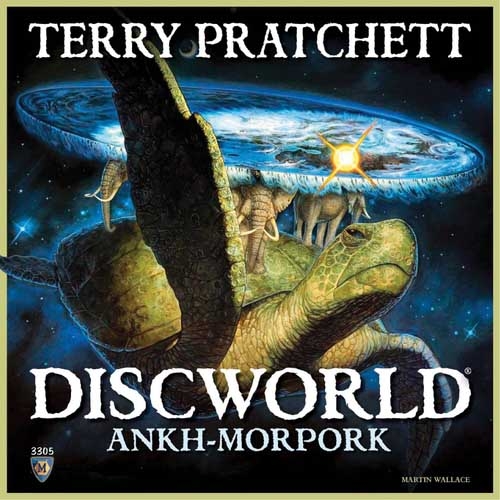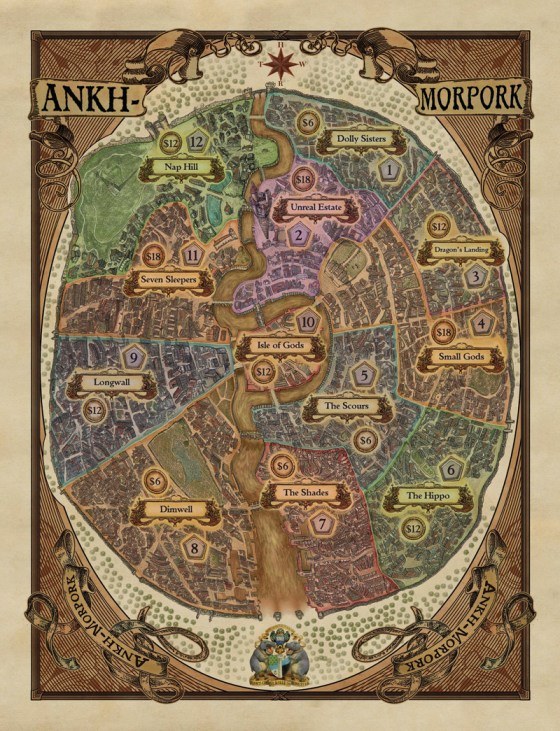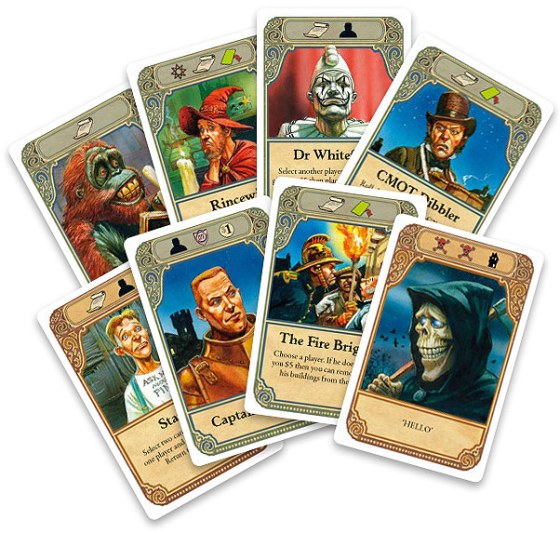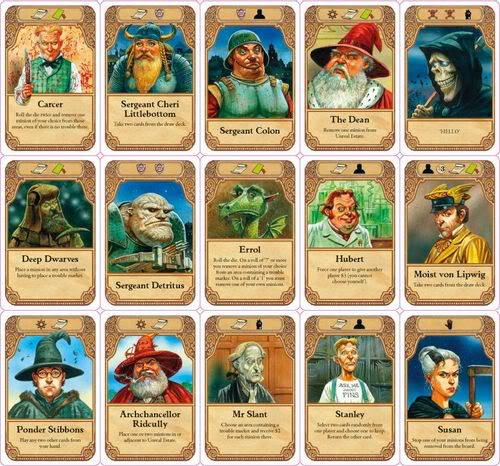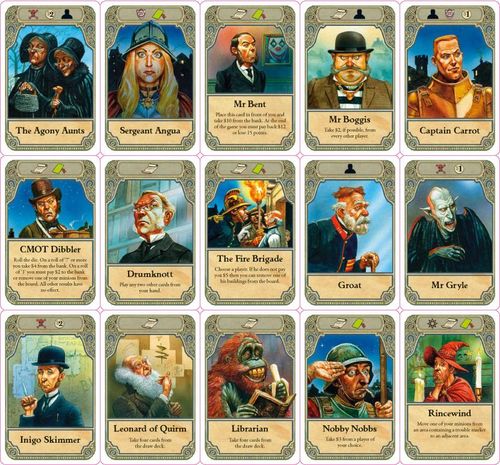Players: 2-4
Average game time: 45-minutes to 90-minutes
Developed by: Treefrog Games
Game Designer: Martin Wallace
Note: I will attempt to add some images of the Personality playing cards etc. but I’ve sadly not got a great camera, so I’ll first have to see what sort of quality level the images are.
I’m stepping off the beaten path of video games and back into another world that I love but have been neglecting somewhat, a world filled with cards, playing pieces and boards, a world that was in so many ways a forerunner to videogames: board games are what I speak of! More specifically over the course of the next month I’ve agreed to play and review two board games based on two of my favorite things: the first is the magical writing of Terry Pratchett in the form of Discworld: Ankh-Morpork, and the second, which won’t arrive until very late October, being the official Firefly board game.
As an avid Terry Pratchett game ( his books and Firefly are the only two things I’ve ever claimed to be a fanboy about) I cracked open the Discworld board game with something approaching nuclear-fission generating levels of excitement, but I suppressed that feeling quickly because board games are an art, their design tricky to master. It’s so easy to create just another generic board game, or to muck up the rules in such a way that everything is ruined. In this board games have something in common with videogames. Most of all I wanted to wipe away my initial excitement in order to slip into a clearer frame of mind in which to write about the game.
Open up the box and quality abounds, starting with the playing board which is a beautifully drawn representation of Ankh-Morpork, even down the horribly brown river Ankh that flows through the centre of the city. The playing board is satisfyingly thick, as well.The game comes packing a grand total of 132 cards, each one lovingly illustrated with characters and locations spanning almost all of Terry Pratchett’s work, and I must sat that almost every character portrayed is drawn just as I pictured them looking in my mind when reading the books. The only slight disappointment comes in the form of of the wooden playing pieces, of which there’s a grand total of 91 to use throughout the game. They’re all brightly colored but very basic. However, from a realistic view the board does get pretty cluttered, especially with four people playing, fairly quickly and so it probably makes more sense to have simple, brightly colored playing pieces with easy to distinguish silhouettes. Finishing things off is 35 silver $1 coins and 17 $5 coins, all of which are made of sturdy card.
On a side note there’s a special version of this game available which features lovingly crafted playing pieces.
The premise of the game is that the delightfully brilliant Lord Vetinari, patrician/dictator of Ankh-Morpork, has suddenly vanished, leaving in his wake a power vacuum which many people are eager to try to fill. This is where the heart of the game comes into play in the form of Personality Cards, each of which depicts a character from Discworld. Each player selects one of these cards at random at the start of the game, and the text on them tells you what you must do in order to claim victory. Your goal remains hidden from all of the other players, and thus the core of the game is attempting to achieve your own ends while figuring out what your opponents are up to, and hindering them where possible, all while trying to throw them off the scent so that they can’t destroy your own carefully structured plan. Suspicion and intrigue are rife, or at least they are in later games since your first couple of games will largely be spent attempting to remember what all the win conditions actually are, although a handy quick reference sheet is included in the box for each player.
The most common of the win conditions, appearing on a total of 3 out of the 7 Personality cards, is to win by pure domination, controlling a specific number of the twelve available territories on the map, which is done by the simple expedient of having more playing pieces in that area than any other player. Other cards present some slightly more interesting options: Lord Vetinari, for example, simply needs to have his minions in enough areas acting as spies, while Commander Vimes wins if the player draw deck runs out of cards, creating an interesting scenario in which the player controlling Vimes needs to carefully interrupt everyone else’s plans while burning through the deck as quickly as possible. Chyrophrase the Troll wins by amassing money, and The Dragon King of Arms claims rulership by causing carnage on the streets, represented by Trouble markers, which I’ll get back to later.
Rather than using dice, the game is controlled almost entirely by using cards taken from the draw pile, each of which has a series of possible actions you can take printed along the top. These actions must be followed from left to right, but you can choose to skip them, with the only exception being the command to draw an Event card. You start the game with five of these cards in your hand, and at the end of your turn you must replenish your stock. The scroll icon lets you follow the text written on the card which can include basic things such things as moving another player’s minions to more interesting things like replacing an opponents building with your own by paying them the initial cost of said building. My personal favorite is the Dr. Whiteface card, because when you decide to play it you ask another player to hand you $5 (a significant amount) and if they don’t then you place the Dr. Whiteface card in front of them. They must keep that card until the end of the game, and cannot get rid of it, forcing their hand size down by one. I can’t tell you how many times me or a friend ended up desperately trying to decide if being asked for $5 meant the other player genuinely had the card or if they were bluffing.
Listed below are all of the possible actions list as icons on the top of the cards:
Assassination – You may remove from the board one Minion, Troll or Demon if the area they are in contains a Trouble Marker
Remove Trouble Marker – Remove a Trouble Marker from the board.
Money – Gain the Money value indicated on the card from the Bank.
Scroll – Complete the text written on the card.
Event – Draw an Event card to see what terrible thing shall occur.
Play Another Card – Exactly what it says on the tin, you may play another card. This allows you to chain together multiple cards in a single turn.
Interrupt – Usually used during an opponents turn to block an action.
Place Minion – Place one of your minions in or adjacent to an area already containing one of your minions.
Place Building – Construct a building in an area containing one of your minions and no Trouble markers by paying the listed cost.
In a clever move the draw deck is actually split into two different colors of cards, brown and green, and when you place the draw deck by the side of the board you put the green deck on top of the brown-bordered cards. The reason for this is that the green-bordered cards tend to contain slightly simpler chains of actions and focus more on placing minions, while the brown deck contains a higher number of cards that allow for more complex plays to appear as the game progresses, creating a natural flow to the action that I appreciated very much.
In a neat touch the game’s designer has also attempted to match the character on the card with the actions available, so for example The Luggage can “assassinate” a minion by eating it and William De Worde earns money for every Trouble Marker on the board, because as well all know carnage sells newspapers. While this matters little to someone with limited knowledge of Discworld, to a fan myself they way character themes are tied in with card abilities is a neat touch.
More importantly the brown deck of cards contain almost all of the Event actions, and since cards with Event actions also tend to be quite useful players will almost always feel compelled to take the risk and play them. Yes, risk, because Event Cards contain potentially devastating effects that can either end up destroying you or even helping you, laying waste to chunks of the board depending on how luck chooses to behave toward you. During Events demons can invade from the Dungeon Dimensions, rendering portions of the board powerless, or dragons can fly in and screw up everything by annihilating every minion and building in a section.
Event Card List:
The Dragon:
Roll the die to determine which area on the board will be hit by the dragon. Remove all minions (including demons and trolls), any trouble marker, and any building from the area affected.
Flood:
Roll the die twice to see which areas are affected by flood. Areas rolled that are adjacent to the river are affected by flood. In player order, starting with the active player, each player mus move their minions from the affected areas to adjacent areas. You cannot move your minion to another area affected by flood. You can still move to an area adjacent to the river. Buildings, trolls, and demons remain in the areas and are not affected by flooding.
Fire:
Roll the die to establish the area of the fire. If there is no building in the rolled area then the random event ends without effect. If there is a building in the area then remove it from the board and roll the die again. If the next area rolled is adjacent to the previous area and there is a building in it then remove that building too (the fire has spread). You continue rolling in this manner until you roll an area that either does not contain a building or that is not adjacent to the last area you rolled.
Fog:
Draw and discard the top five cards from the draw pile. Make sure you and the rest of the players can see which cards have been discarded.
Riots:
If there are eight or more trouble markers on the board then the game ends immediately. You now work out who has won by adding up points (see page 6). Please note that if a player is Commander Vimes then they do not win at this stage, although they may still win on points.
Explosion:
Roll the die and remove any building in the area of the same number.
These titanic and board-shaking events do fit in well with the theme of the game, but obviously due to their random nature they can be inherently frustrating, and so I have no doubt that many players will find it hard to reconcile their careful planning and tactics being ruined by a cruel whim of fate. However, I do suppose you could remove event cards altogether if you feel they take away from the overal experience, though personally I enjoyed having the element of luck involved.
The most common action, especially within the green deck, is to place a minion on the board, a little wooden avatar who is a physical representation of your influence. The only limitation is that little wooden gentlemen or lady in question can only be placed in or adjacent to an section of the city already containing one of your minions. On the most basic level having minions on the board is useful for seizing control of areas through sheer numbers or blocking a player looking to do just that, but having a minion in a section of the board also allows you to build a property there by paying the cost listed in that area. Like minions there’s several reasons why you might choose to construct a property: the first is that they count towards controlling an area and are harder to get rid of than minions, with fewer cards offering abilities to do so; the second reason is that the value of the constructed building counts toward your total wealth, and therefore can help you win while playing as Chyrophrase the Troll, whose victory condition is that you amass a total of $50. Finally, when you put up a building you gain that areas corresponding card which gives you a special ability once per turn, like collecting money from the bank or allowing you to draw an extra card if you discard one.
Complicating matters are the troublesome Trouble Markers which represent the chaos erupting within the city walls as the various characters wrestle for control of Ankh-Morpork, and it’s only while one is present in an area that you’re allowed to assassinate a minion there. Whenever a minion is placed in an area already containing one or more minions, regardless of whether they are yours, a Trouble Marker is also placed there. Should a minion be removed from an area the Trouble is also taken away, regardless of whether or not there’s still a pile of pesky minions remaining. Trouble markers also stop you from constructing a building in that part of Ankh-Morpork, and of course certain card effects and Events are linked to them as well. At first Trouble markets seem to be little more than an awkward distraction, just something else that you’ve got to remember while you play, but once you’ve got a couple of games under your belt you realise than there’s subtle strategy involved in manipulating. With careful play you can use Trouble markers to annoy other players, and some cards allow you to actually place even more of them on the board. There’s also a personality card by the name of Dragon King of Arms whose victory condition requires there to be a certain amount of Trouble markers on the board, since he does so enjoy carnage.
So, the depth of the game, as you’ve already doubtless figured, stems from the victory conditions. As you attempt to achieve your goals you must carefully scout the other players for clues in order to figure out what they are attempting to do so that you can perhaps slow them down, all while trying to disguise your own moves. Strategy comes from careful play and deceit, and competing with a few good people is brilliant fun because of that. At first the game seems simple enough, but the more I played the more I learned and came to conclusion that Discworld has a pleasing amount of depth to its mechanics, while never being overly complex so as to make it impossible for all but the most dedicated of players to tackle. It doesn’t take long to learn the rules, but mastering the game takes some time, and doing so is incredibly satisfying.
As an example of how people can keep you guessing, imagine another player constructing a house: buildings are far harder to get rid of than minions, so did they build it in order to have a continuous presence to control the area? On the other hand buildings count toward a player’s total worth, so perhaps they’re consolidating their cash in something physical as they work toward Chyrophrase’s win condition of amassing $50? Of course they could simply be throwing you off their trail altogether, stalling for time.
The only true problem in the game stems from the nature of controlling by cards. Should a run of bad luck afflict a player they can find themselves with useless cards that leave them unable to do much toward their goal, and no amount of strategic player can help. However, this would be an extremely rare case as usually you’ll at least have cards that can hinder other players progression, giving you time to draw new cards and get back on track.
I do have some doubts about how balanced some of the victory conditions actually are, likewise the draw cards, but without playing many, many more games of Discworld: Ankh-Morpork it’s hard to say. For example, if Commander Vimes has to wait for the deck to run out then is he not at something of a disadvantage in a 2-player game?
If I am going to nit-pick I would say that the game could have done with having a few more coins as we almost ran out on a few occasions and were constantly having to swap five $1 coins for a single $5. Also, the rules don’t make a couple of things clear, though players should easily figure out what to do themselves. Finally, and this really is being picky, the packaging could have been better. While the box is superb, the plastic lining contains only three sections for the cards, despite there being a need for five (event, personality, area and the brown and green draw decks) so when you go to play you’ll find yourself having to sort the cards out again. Only the middle card holder has cut out grooves to get your fingers in to life out the cards, so with the other two you’ve got to sort of wedge your hand in there. The different colored playing pieces are all jumbled together in a single bag and share a big recess with the coins, so I also recommend getting yourself some small, sealable plastic pockets to put them in, again so you have less sorting out to do.
Gameplay mechanics aside I feel that the theme of the game works well. As a Discworld fan I couldn’t help but feel a thrill when I drew a card with the with hooded skull of Death etched upon it, his grin leering at me and his ability to assassinate two minions making him especially useful. I couldn’t help but enjoy the fact that playing the Nobby Nobbs card let’s you steal $3 from another player, or that Rincewind is the only green card in the entire game with an Event symbol, because Rincewind always turns up where you least expect him and with trouble right behind him. I loved battling for control of a city that I know so well, using characters and locations that have been a part of my life since I was but a child learning to read. I loved that minor characters and major characters alike are included. As a fan of Terry Pratchett I simply loved this game.
Discworld: Ankh-Morpork is not the most complex nor nuanced of games, but that means it’s also accessible, making it a brilliant family game whilst having enough meat for more advanced players to enjoy as well. Most importantly I thoroughly enjoyed the game every time I played as it fosters a suspicious uet friendly atmosphere as everyone assumes their given role and plots to take over the dirty, dark city of Ankh-Morpork.
The Good:
+ Quality components.
+ Discworld theme works well.
+ Gameplay mechanics are fun.
The Bad:
– Packaging could have been better.
– Room for strategy, but bad luck can get in the way of that.
The Verdict: 4/5 – Great
As a Terry Pratchett fan, and as a board game lover, I have to say that this is a well designed, easy to learn and fun game with just enough lashings of strategy to keep you coming back for more. Recommended.

